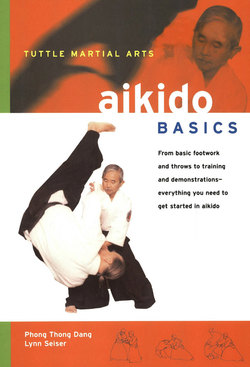Читать книгу Aikido Basics - Phong Thong Dang - Страница 13
На сайте Литреса книга снята с продажи.
ОглавлениеAIKIDO REQUIRES appropriate clothing and equipment that will i help you fit in and train properly.
Clothing
There are three basic personal requirements aside from the traditional uniform, or dogi: the belt, selected undergarments, and ultimately, the hakama.
Uniform (Dogi, or Gi)
The most important piece of equipment is the purchase of the dogi. The dogi, referred to as a gi, is the traditional martial arts uniform. It consists of a jacket and pants. The jacket is a wraparound, long-sleeved jacket without buttons, made of bleached cotton. The pants are often of the same material, with either a drawstring or elastic waist. Most pants have reinforced seams and a gusset crotch for increased flexibility. The legs should not be so long that they drag on the ground. There are many styles and weight of dogi. Many students start with the less expensive, lightweight karate-style dogi. Advanced students prefer to wear the heavier judo-style dogi. Some dogi come with elaborate embroidering or calligraphy. Some schools sell their preferred dogi, while others include it in the enrollment cost.
The Belt
The belt wraps twice around the dogi and ties in front with a square knot. There are two ways to tie the belt. You can either start with a small section of the belt in front and then wrap the belt around you twice, over itself, before tying it in front. Another way is to start by holding the belt in front of you, with the middle at your center, and then wrap it around you until both ends are in front.
The belt represents more than something that holds your pants up and your top together. Your belt represents your rank and your training. People may ask what color belt you wear. Your dogi will last you for years, but with disciplined practice, you will earn a different belt of another color. In reality, however, the color of the belt is not as important as the skill and integrity of the person wearing it.
Undergarments
Many people find it useful and courteous to wear an undershirt under their gi while training. For many women, this becomes a means of maintaining a sense of modesty. Others appreciate the absorption quality of an undershirt. It is a personal preference.
Since aikido does not use strikes or kicks directly to the groin area, it is not necessary to wear any sort of groin protector. Wearing undergarments that provide some sense of support is useful and provides both safety and comfort.
The Hakama
The hakama is the formal pleated skirtlike pants worn by advanced students. The hakama symbolizes the accomplishment of many hours and years of training, dedication, and discipline. It is a status symbol in some schools. Some schools allow women to wear the hakama out of modesty. This comes from traditional Japanese culture, and should not be considered politically incorrect or sexist. Some modern schools do not make this exception, however.
There is a ritual for folding your hakama when you are finished training. It provides a time to reflect on your training and your purpose for taking aikido.
You may have some difficulties getting dressed at first. With time, putting your uniform on will be a part of your ritual for preparing your body and your mind for training. Your uniform will become a statement of who you are and what you will become. Wear it proudly.
Equipment
Your school will provide most of the equipment needed to practice aikido. The most important is the mat on which you will train. The mat provides a safe place to fall and roll while practicing the basic techniques.
The only pieces of equipment that you will eventually have to buy are your weapons. Weapons training begins at various times for the beginner in aikido. There are three primary weapons used in aikido training: the jo, or wooden staff; the bokken, or wooden sword; and the tanto, or wooden knife.
